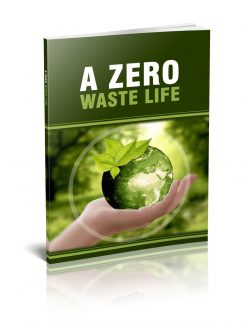
 License Type: Personal Use
License Type: Personal Use  File Type: ZIP
File Type: ZIP
 SKU: 63782
SKU: 63782  Shipping: Online Download
Shipping: Online Download
Sample Content Preview
CHAPTER 1
LEARNING MORE ABOUT PLASTICS
The question about whether plastic is always bad or not is starting to be asked around the world. Many areas of the world are banning plastic in many forms, especially single-use plastic, plastic bags, straws, and plastic that tends to go straight to landfills almost immediately after use. But are there times that plastic is okay? Or is plastic always bad?
Recycling Doesn’t Help (Much)
One problem is that many people think that all plastic can be recycled. Sadly, most of the plastic you put in the recycle bin cannot be recycled. In fact, less than 10 percent of plastic gets recycled. Therefore, most of it is winding up in landfills, even when you dutifully put your plastic in the bins.
The Main Problem Is Single-Use Plastic
Any type of plastic that is considered a single-use plastic is usually of low quality and not even made well enough to use in recycling. That includes a lot of the plastic bottles that you drink water and soda from. When plastic is recycled, it becomes lower quality and cannot be used for much since it’s considered contaminated.
Another Problem Is Colored Plastic
You know the bottles your detergent comes in? Yeah. Those. They cannot be recycled. If you’ve been putting them in your bin, you likely don’t realize that they’re being bundled up and put right into the landfill because they are not reusable at all. The only way you can really reuse them is to keep them and repurpose them. Try buying white or clear containers instead to be assured they have more of a chance of being recycled.
Biodegradable Plastic Is Not Okay
Many single-use plastics like forks are labeled as biodegradable. This makes you think that you can put them in the compost pile, but you can’t. No single-use plastic is either recyclable or compostable. They’re supposed to break down fast but only in a specialized high heat center made for helping these things decompose. It won’t happen in your back-yard compost pile.
Learn Your Plastics
There are several types of plastic to learn about, and yes, most of them are not suitable for the environment. But some are worse than others, such as anything with PVC or BPA.
The best thing you can do is to stop using plastic for single-use needs. Instead, find alternatives such as reusable glass and metal containers, which are much easier to recycle when you’re done with them. Only buy plastic that you plan to keep forever and make sure you only buy it from used sources when you can.
CHAPTER 2
TOP 10 MATERIALS FOR YOUR SUSTAINABLE HOME
Finding sustainable materials for your home requires that you develop an understanding of manufacturing processes. Even the materials listed can become not so sustainable if the growers and manufacturers aren’t using eco-friendly practices, so check out any company you want to buy from first.
Bamboo
Bamboo fiber is an excellent material to use for carpets, window treatments, towels, and the like. If you can find textiles made from bamboo fibers, including bamboo hardwood, you can really create a house that is exceptionally eco-friendly, as bamboo thrives quickly and grows in just three years compared to 120 years for a tree.
Rammed Earth
Think of this like building a sandcastle. Only it’s sounder, and you can live in it. It’s made with a mixture of soil and cement that you compact into forms to make the walls.
Recycled Steel
When you can find recycled steel, it might cost a little more right now, but the fact that you’re using something again makes your home even more eco-friendly than if you just used new steel. Consider using something like a steel cargo container to build a house with.
Sheep’s Wool
When it comes to using fibers, sheep’s wool is very sustainable. Sheep are not harmed when they are sheared, and they can be sheared repeatedly throughout the life of the sheep.
Straw Bales
Did you know that you can build a house with straw? Well, you can, and it usually costs about 10 to 15 percent less if you build it yourself. The labor is intense so that it can add to the building cost, but the cost to the environment is far less than traditional building.
Precast Concrete
This sustainable green product is durable, uses less water, and is a primary material used in most LEED-certified buildings today. But it will cost you a little more for your build due to the process it takes.
You can expect to spend about 8 percent more using precast concrete.
Reclaimed or Recycled Wood
While this type of material is an excellent choice for your building needs, you will end up spending more on it than traditional wood choices. However, the overall cost isn’t that much more when you consider other benefits of using reclaimed or recycled wood, such as using something already made and giving it a new life.
Cork
You can build an amazing house with recycled cork blocks. Cork comes from trees, but if you can reuse it, then you’re doing something very sustainable. In fact, it’s already sustainable due to the way they harvest it. They can harvest one tree up to twenty times compared to one time if you use wood. Cork works excellent for floor tiles, insulation, and more.
- License: Personal Use
- Category:Ebooks
- Tags:2021 Ebooks Personal Use







